Flow Blue is a sort of pottery that is modeled after the well-known porcelain. It is distinguished by elaborate patterns painted with the application of cobalt oxide that is blurred in their picture at the same time.
This was not done on purpose, but rather as a result of a production blunder that became quite popular in Victorian times and is still a very prized piece today.
However, as with every collection, there is a backstory behind it and a lot to learn if you want to get into this profession. In this post, we’ll introduce you to the interesting world of Flow Blue, including how it began, the various designs, and the most precious and wanted things among collectors.
That way, you’ll have a better idea of what’s going on and be able to enter the realm of flow blue with more confidence and security. Keep in mind that the more information you have, the better decisions you will be able to make.
Table of Contents
What is the History of Flow Blue?
Flow Blue is a porcelain style that was created by accident in the 1820s in England when people tried to emulate famous Chinese porcelain with blue patterns by printing with cobalt oxide.
This style of porcelain is thought to have been invented by Staffordshire potters of England. Chinese porcelain became a luxury item for European high society in the late 18th century and throughout the 1800s, and was immensely popular not just in England, but also in Holland, Germany, France, and the United States.
Porcelain was immensely popular in the 1800s, especially in England. It took nearly a century for English potters to develop a process of salt glaze on earthenware that produced an extremely bright white appearance that resembled the famed Chinese porcelain.
Instead of hand-painting the patterns of various motifs using cobalt oxide, they developed a process known as “transferware,” which required etching the picture onto a copper plate and then pressing it into the pottery like a stamp.
They utilized a chemical finish that gave it the blue tinge that is so typical of blue and white Chinese porcelain when burned. However, the first attempts failed because too much chemical was employed, causing the blue to blur on the white background.
Many people saw this ghostly or blurry aspect as something unusual and unique, and as a result, the Flow Blue became well-known.
Other theories about the exact origin of flow blue contend that it was not an accident, but rather a deliberate act. The original copper plates on which the image was engraved were not completely clear, and their polish did not compare to the handwork.
They believe that ammonium chloride was added to the oven to cover the low quality of the drawings, causing the blue pigment to overlap and merge in with the white background, creating a unique blur effect that was very rare and appealing at the time.
It was not only popular in Europe because of the unique finish, but it was also exported to America, particularly the United States, where it was quite popular.
From 1820 to 1920, a century of collectible blue flow artifacts was manufactured. Johnson Brothers and Wedgwood are two of the most well-known makers of this design. Around 1,500 collectible patterns were made in total.
The decorative motifs incorporate pastoral scenes, floral patterns, and many prints representing historical passages because their popularity originated during the Victorian era.
With today’s collectible patterns, something even stranger happened. Because the procedure was not accurate, it occurred frequently that the producers surpassed the blurring of the pieces, which were not accepted in Europe; as a result, they were shipped to the United States, where they were welcomed and developed a market for these manufacturing faults.
Because the cost of creating these products was low, they were more accessible to the poor and middle classes, resulting in a long-term market.
After the First World War, the Flow Bule fell out of favor, but, like other styles, it resurfaced in the 1980s and has remained a collector’s item ever since.
Flow Blue Styles
Many patterns and styles have been made throughout the 100-year popularity of flow blue, but four of the most popular, well-known, and wanted by collectors have emerged.
Romantic Designs
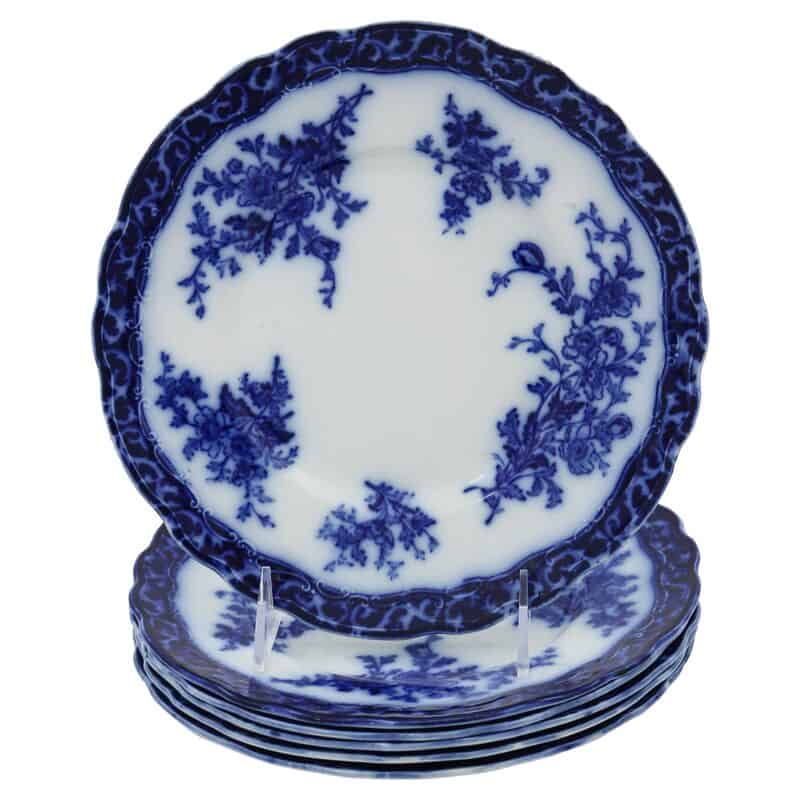
Touraine Flow blue’s early popularity was influenced by romanticism, as it was popular during the Victorian era. As a result, there are a lot of patterns of pastoral sceneries in this style. Pastoral art emerges between the rococo and neoclassical periods when joy and celebration of life predominate in ordinary situations. This style had little regard for the state, let alone the church, and its goal was to make room for comedy, grace, and light sexuality.
Aside from pastoral scenes, the most common topics are depictions of everyday life or images of fun and oscious activities of European aristocracy, who are always trying to get away from everything that is solemn and spiritual.
John William Adams is a well-known artist who is known for romantic themes such as Italian Landscape and Watteau. Jenny Lind by Arthur Wilkinson and Thomas Fell’s Excelsior, designed in the mid-nineteenth century, are other well-known patterns.
Oriental Patterns
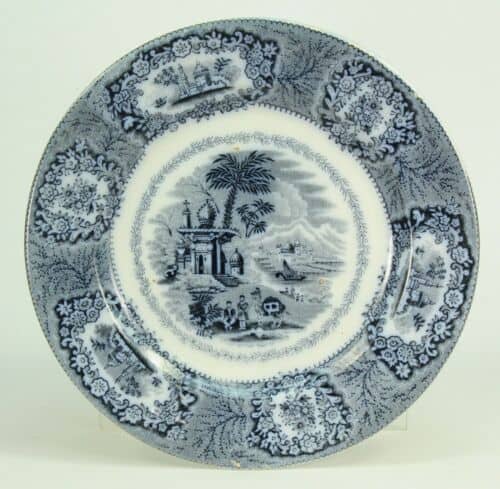
It is important to remember that Chinese Blue porcelain is not unique to China; in fact, the technique of painting porcelain with cobalt oxide originated in the Middle East and was popularized in China thanks to eunuchs in the service of Chinese emperors. As a result, the embellishments are not unique to Chinese culture; Arabic characters can be found in a variety of Middle Eastern styles and motifs.
Even though cobalt oxide was a scarce element that had to be imported from Iran, Japan had already embraced the style and began creating its art before blue-tinted Chinese porcelain became famous in Europe.
As a result, there were already many Arabic, Chinese, and Japanese designs when this sort of porcelain came to Europe. Europeans did not distinguish between places at the time, and anything that originated from Asia was referred to as oriental art or Asian designs.
When European potters attempted to emulate the oriental style, they simply translated the art from romanticism and replaced pictures of European courts with Chinese-styled figures. Eastern sceneries such as vast mountains, pagodas, temples, and gardens were also incorporated.
Thomas Edwards is one of the most famous artists in this style with works such as Cabal and Cashmere. Other famous designs are Amoy by Davenport and Manila by Podmore & Walker and Burgess& Leigh.
Floral Designs
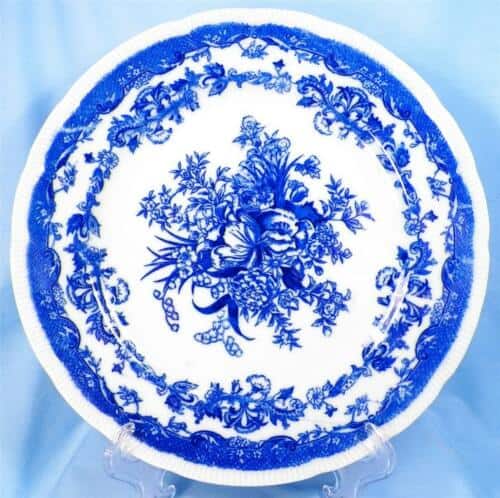
Floral patterns have been popular throughout history from early ironstone to porcelain, but flower arrangements were the protagonists of many art forms at the time flow blue became fashionable. This is because it was a period of colonization throughout Europe.
In other parts of the world, such as Africa and America, England, France, Germany, Holland, Spain, and Portugal had a presence, and many new kinds of plants and flowers were discovered.
This boosted the popularity of flower arrangements in art, which now came in a wide range of styles, and their influence spread to flow blue, where we can see wonderful patterns of a variety of flowers.
The Blue Danube by Johnston Brothers, which dates from the turn of the twentieth century, is one of the most sought-after collector patterns. Other prominent designs are Waldorf by New Wharf Pottery, Wood and Sons’ Seville, and Ridgeways’ Lonsdale.
Patterns of brush strokes
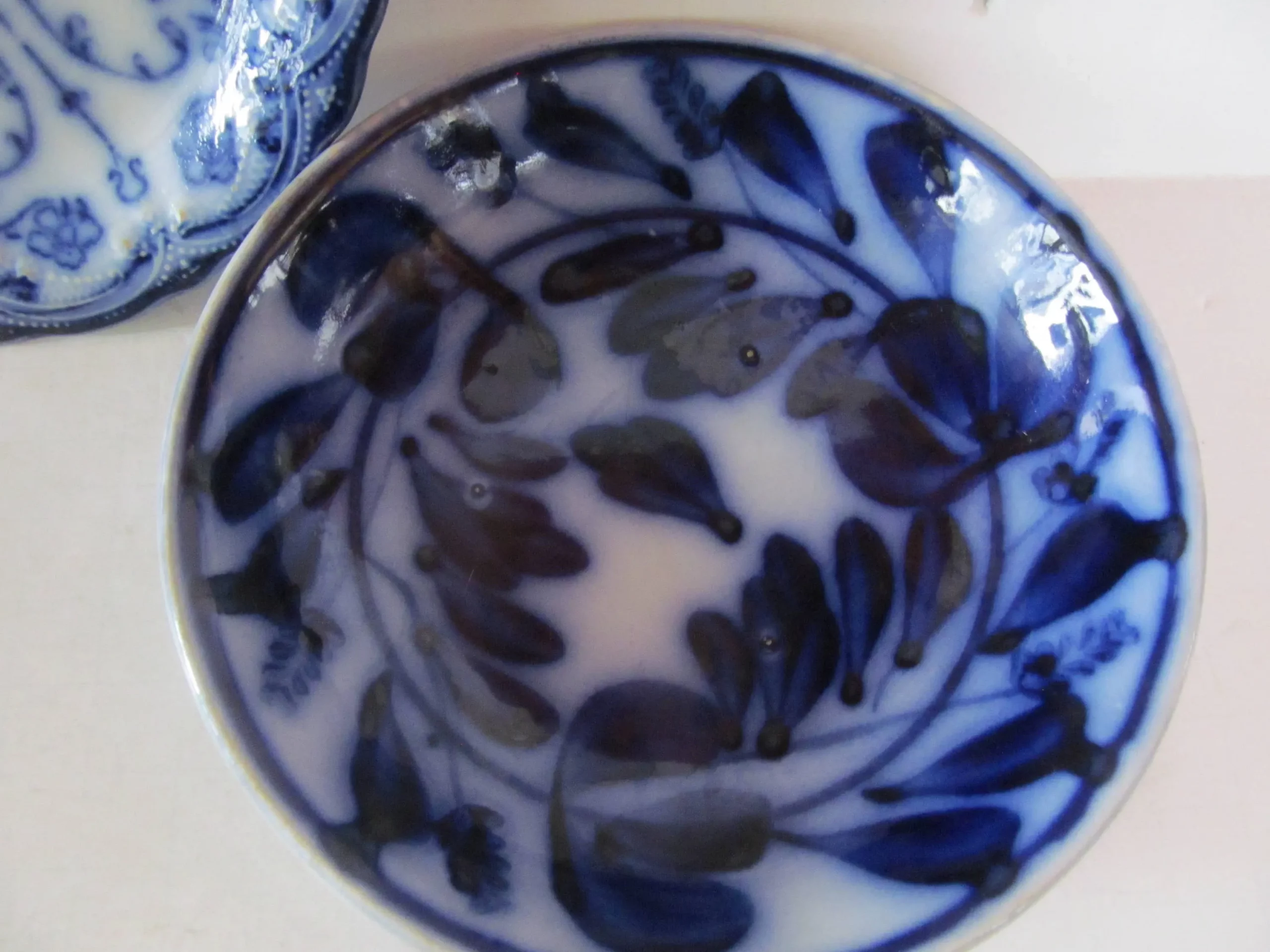
This style is distinguished by the presence of hand-painted brushstrokes. The copper or pink glow that most of these pieces have is another of its key traits and forms of identification. It’s also important to note that this type of hand painting isn’t just confined to cobalt blue, but also includes various hues, giving it a colorful aspect.
Thomas Walker’s Strawberry, Tulip, and Sprig are among the most well-known designs. Blueberry and Blue Bell, both designed in the mid-nineteenth century, are two more prominent designs.
How to Recognize Flow Blue
Many Flow Blue companies stamp their logos on the bottoms of items like dinnerware, vases, and teapots. Many of the manufacturer’s stamps are likely to be blurred as well. To recognize blurry images, it is recommended that you use a magnifying glass.
Many books contain a large number of designs, allowing you to determine which ones are truly valuable. However, bear in mind that most of these catalogs were created many years ago, and the pricing and popularity of specific patterns may vary. Although it has evolved, it is still a very helpful tool for identifying items.
Another option is to look up the names of the manufacturers and the forms of each seal’s design on the internet. This search can bring up a list of goods with that design from different manufacturers. You might be able to obtain an estimate of the value of each pattern in addition to locating the pattern you’re looking for.
It’s worth looking into internet retailers advertising that sells Flow Blue collectibles to get a sense of how much this popular sort of porcelain is currently worth.
The costs vary greatly and are dependent on each piece, but to give you an idea, Flow Blue products that are offered in online sales ads can cost anywhere from $20 to $600, depending on how well they have been preserved. Some pieces cost more than $600, but they are highly rare and are typically sold to museums or collectors with a large investment budget.
If you want to learn more about Flow Blue, we recommend looking for works written by authors like Mary Gaston, Petra Williams, or Jeffrey Snyder. His books are an excellent source of information about this art and one of the most important resources for Fow Blue enthusiasts.
How to Value Flow Blue
The value of collectibles is always going to fluctuate. It happens with all items and the Flow Blue is no exception. You must bear in mind that the price will change according to the demand for the object, its rarity, its good condition, and even the global economy plays an important role.
You should also keep in mind that the Flow Blue was more popular in some countries, thus the market varies based on your location. As previously stated, several Flow Blue works were initially rejected in Europe and then imported to the United States, where they were sold at considerably cheaper prices, resulting in a second or third-hand market.
As a result, getting a better price will depend on where you are in the world or which market you are selling your items to.
The condition of these artworks is another aspect that raises their price. The easier they are to sell and the more you can ask for a greater price, the more entire they are and free of chips and cracks.
Items with handles, spouts, or lids are more valuable since they are harder to keep intact and frequently break from use or transportation.
Finally, keep in mind that some parts are more expensive since they were produced in smaller quantities. Several plates and cups were manufactured for each sugar bowl or teapot.
As a result, if you own products that were produced in lesser quantities, they will be valued considerably more on the market and will be easier to sell.
Remember that collectors enjoy rare and unusual products; even if it appears to have a manufacturing flaw and is worthless to the average person, they could be pure gold to a collector.
How to Clean and Care for Flow Blue
You must constantly wash vintage dishware with warm water rather than cold water to maintain it in pristine condition (this also applies to Flow Blue).
Avoid extreme temperature changes and never put it in the dishwasher to be cleaned. We also recommend that you use a gentle dishwasher and avoid washing with very hard brushes.
Pack your crockery well in a paper towel or cover it with a cloth piece by piece if you wish to store it.
Finally, we’d like to provide you with some useful information on how to remove stains from antique dishware. Rather than experimenting with different cleaning agents, we recommend purchasing hydrogen peroxide (H2O2) 8 percent for food grade.
You should put on gloves before using them because they might cause skin injury if it comes into touch with it. Pour the solution over each plate or object that needs to be cleaned and leave it to soak for two days. Then, pour the solution back into the container for later use, and place the soaked plates in a cold oven.
Then bake them for an hour at 200 degrees Celsius in the oven. What will happen is that the H2O2 that was put into the plate will evaporate, and the stains on the plate will vanish with it. Try it; it’s a wonderful secret for restoration.
We hope you found this article to be helpful. Whether you have flow Blue in your possession and are looking to sell it or want to purchase one of these collection items, we can help.
You now have a better understanding of its history, worth, how to identify it, and which nations it is most popular in.
Remember that the value of your Flow Blue items will only increase over time, therefore we hope you will take our advice and protect your pieces by keeping them clean and sparkling as if time had not gone.
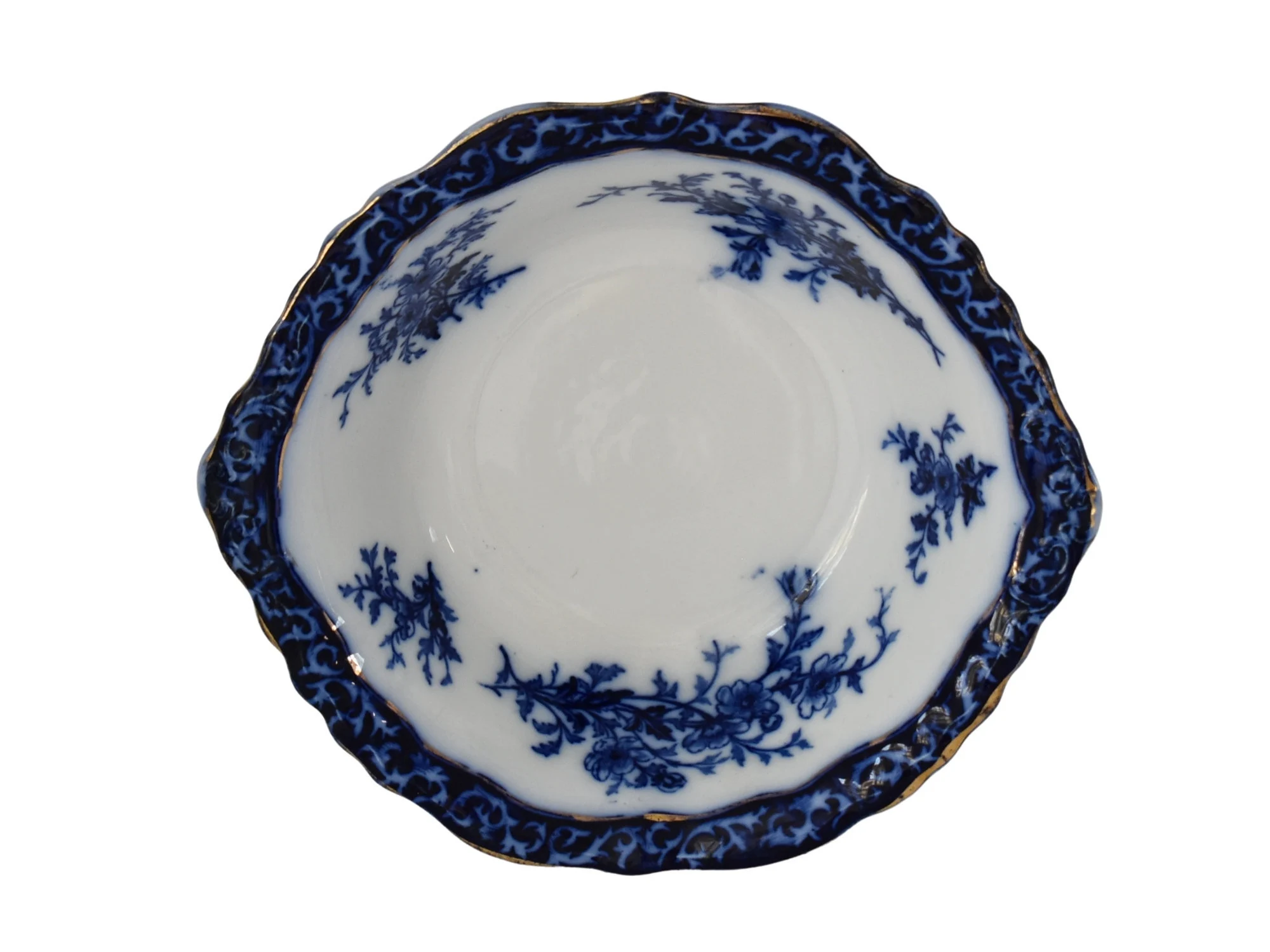
I have two pieces that I need to sell of Flow Blue Trying to find the best place to sell and not get garage sale prices